Marvel’s The Monster of Frankenstein, Part One
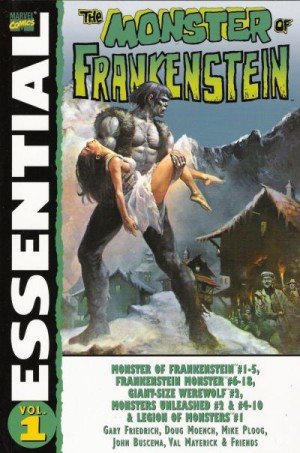 Click on images for larger versions.
Click on images for larger versions.
Following the success of The Tomb of Dracula in 1972, Marvel Comics launched The Monster of Frankenstein the following year. Gary Friedrich and Mike Ploog kicked the series off with a fairly faithful three-part adaptation of the Mary Shelley novel.
At the outset, Marvel determined to keep the Monster in period. This was an interesting approach considering the modern update Dracula had received. Vampires were an easier sell for the twentieth century as numerous film and television updates had already established contemporary vampire stories whereas the Frankenstein Monster somehow seemed an antiquated concept, despite the character’s ongoing appeal.
It is important to remember that at the time the series debuted, literary critics had not yet embraced Mary Shelley’s work as a classic. Shelley, like Bram Stoker, was looked down upon as low-brow and her work was not afforded serious consideration.
Television syndication of the Universal Frankenstein pictures of the 1930s and 1940s and the character’s transformation into the patriarch on the 1960s sitcom, The Munsters were largely responsible for its longevity. It would be several more years before Shelley’s cautionary tale would gain widespread acceptance as a modern myth whose resonance had not diminished with the dawn of the Industrial Revolution.
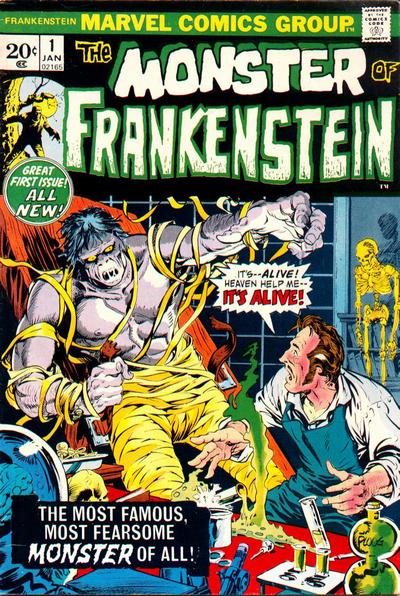 The first issue of The Monster of Frankenstein opens in January 1898 with Arctic explorer Robert Walton IV, the great-grandson of the eighteenth century mariner who encountered the dying Victor Frankenstein and his Creature in the frame for the original novel. Captain Walton’s descendant is seeking the frozen body of the monster in the Arctic wastes having learned of it in his great-grandfather’s journal.
The first issue of The Monster of Frankenstein opens in January 1898 with Arctic explorer Robert Walton IV, the great-grandson of the eighteenth century mariner who encountered the dying Victor Frankenstein and his Creature in the frame for the original novel. Captain Walton’s descendant is seeking the frozen body of the monster in the Arctic wastes having learned of it in his great-grandfather’s journal.
Gary Friedrich’s new frame for Shelley’s story serves a useful purpose in that it assures the reader that when the Monster meets his fate at the conclusion of the novel adaptation (at the end of the third issue), Marvel will not be faced with the difficulty of undermining the creature’s literary end with the start of the fourth issue.
Friedrich’s script owes much to nineteenth century adventure classics in his depiction of Robert Walton IV and his first mate, Canute as they ceaselessly contend with every obstacle possible from natural disasters and bad weather to threats of mutiny in their effort to bring the newly located frozen carcass aboard their ship.
Captain Walton tells his cabin boy the first third of Shelley’s novel during the balance of the first issue. Friedrich ends the story on a cliffhanger as a storm hits and the frozen monster begins to thaw and return to life. Mike Ploog’s artwork is sharply detailed and suitably gothic. No other artist would capture the character so well during Marvel’s run.
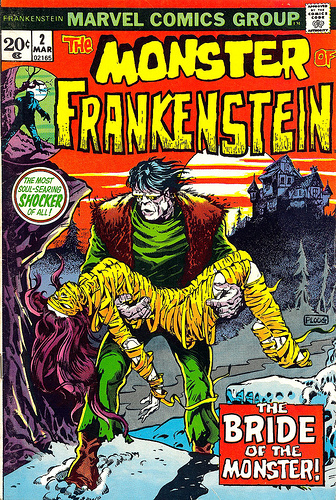 The second issue opens with the Monster escaping the boat after the expected rampage to assure the reader that a good freeze has done nothing to diminish the threat he poses. Walton resumes his narrative, largely faithful to the original apart from Friedrich’s decision (in the interest of drama) to have Victor animate the Monster’s intended mate before having him dismember her in disgust. The second issue ends with Walton’s boat now racing toward an iceberg.
The second issue opens with the Monster escaping the boat after the expected rampage to assure the reader that a good freeze has done nothing to diminish the threat he poses. Walton resumes his narrative, largely faithful to the original apart from Friedrich’s decision (in the interest of drama) to have Victor animate the Monster’s intended mate before having him dismember her in disgust. The second issue ends with Walton’s boat now racing toward an iceberg.
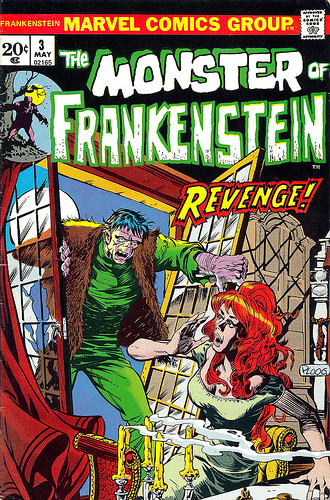 Issue three concludes the novel adaptation with the Monster heroically saving Walton and his crew from the sinking ship before relating the conclusion of the Shelley novel. The issue ends with yet another calamity, this time a cave-in that buries the monster and shipwrecked sailors beneath tons of rubble.
Issue three concludes the novel adaptation with the Monster heroically saving Walton and his crew from the sinking ship before relating the conclusion of the Shelley novel. The issue ends with yet another calamity, this time a cave-in that buries the monster and shipwrecked sailors beneath tons of rubble.
Issue four is where Friedrich really ramps up for the series’ first post-novel story arc. The Monster is still portrayed as basically heroic, once again saving the lives (albeit, temporarily) of Captain Walton and the cabin boy. While setting out for food, the Monster is set upon by a tribe of Neanderthals that have survived the millennia in the lost frozen wastes.This is pure Edgar Rice Burroughs-inspired pulp hokum, but Friedrich makes good use of its influence.
Ploog’s artwork drives home the point that the Monster shares a definite similarity to these evolutionary throwbacks. The story may largely be filler, but the issue concludes on a dramatic note as Walton confesses on his death bed that he was hired to find the Monster by the descendant of his creator, Dr. Vincent Frankenstein. The Monster sets off to find this heir to the Frankenstein legacy in the hopes that he will help him where his genius ancestor failed.
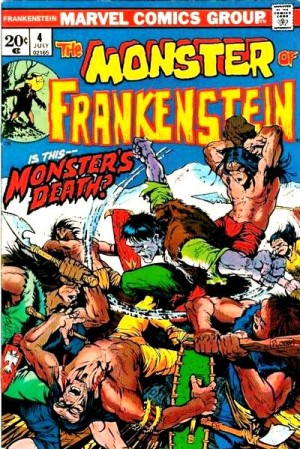 While it is easy to look upon Marvel’s The Monster of Frankenstein as little more than a Victorian variation on The Incredible Hulk, Friedrich’s stories show an understanding of the character and a desire to do more than merely recycle the Universal monster rallies of decades past, although their influence will show eventually.
While it is easy to look upon Marvel’s The Monster of Frankenstein as little more than a Victorian variation on The Incredible Hulk, Friedrich’s stories show an understanding of the character and a desire to do more than merely recycle the Universal monster rallies of decades past, although their influence will show eventually.
This Marvel Comics series may not be as literate as the classic novel nor as well-written as The Tomb of Dracula, but it is consistently entertaining. These early issues with Ploog’s artwork remain a joy to behold, and Friedrich earns merit for ingenuity and a greater understanding of what makes the character and concept work than what had previously been attempted by any other writer in film or fiction.
Read Part Two of this article here.
William Patrick Maynard was authorized to continue Sax Rohmer’s Fu Manchu thrillers beginning with The Terror of Fu Manchu (2009; Black Coat Press). He is currently working on a sequel, The Destiny of Fu Manchu as well as The Occult Case Book of Sherlock Holmes. To see additional articles by William, visit his blog at SetiSays.blogspot.com
[…] Part One of this article here. Click on images for larger […]